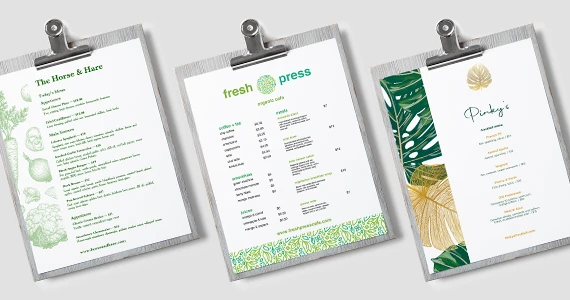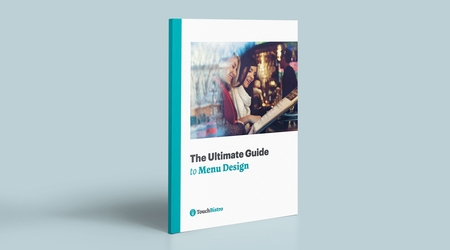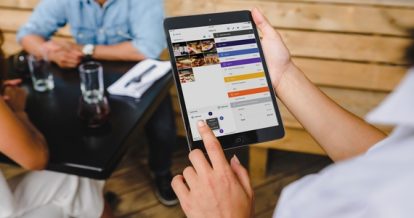Running any business is simply about selling something for more than you bought it so you can make a profit. Running a restaurant is no different, and if you want to be profitable and succeed over the long term, your restaurant menu pricing needs to be accurate.
But, how do you accurately price your menu items?
Focusing on the numbers, such as the desired gross profit margin and ideal food cost percentage, is a good place to start.
But if you want to be profitable, you need to think beyond just the numbers. Odds are, you can charge much more purely because you deliver a better customer experience than your competition.
In this article, we’ll help you master a pricing strategy for your restaurant menu by covering:
- How to price menu items based on ideal food cost percentage
- How to price a menu based on gross profit margin
- 7 restaurant pricing tips to maximize menu profits

Creating an eye-catching restaurant menu has never been easier thanks to these free restaurant menu templates.
Restaurant Menu Pricing Based on Ideal Food Cost Percentage
Before showing you how to price menu items based on the ideal food cost percentage, we need to arm you with a few basics: food cost percentage, ideal food cost percentage, and how to calculate both.
What Is Food Cost Percentage?
Food cost percentage indicates what percentage of sales you spend on food and beverages. It is either plate cost expressed as a percentage of the selling price of a dish, or period cost expressed as a percentage of total sales for a specific period, where:
- Plate cost is the cost of a single dish and,
- Period cost is the total food cost calculated over a particular period
Because we want to price menu items, we’ll focus exclusively on calculating plate cost as a percentage of the selling price.
How to Calculate Food Cost Percentage
To calculate food cost percentage for a specific period, take food costs, divide it by sales for the same period and multiply it by 100. For a menu item, take the plate cost, divide the cost by the selling price, and multiply it by 100.
Ideal Food Cost Percentage
Ideal food cost percentage goes by several names: maximum allowable food cost percentage (MFC) or targeted food cost percentage. It is the food cost you cannot exceed if you want your restaurant to remain profitable. To calculate it, use this formula:
MFC = 100 – ( (Labor costs + Monthly Overheads + Profit Goal)/ Total Sales x 100) ).
An Example of Pricing Items Based on Ideal Food Cost Percentage
With the basics out the way, here’s how to calculate the menu price of a simple burger and fries dish with food cost in mind.
Step 1: Determine Your Ideal Food Cost Percentage
In most restaurants, the ideal food cost percentage is between 28 and 35%. But every restaurant is unique, so take the time to calculate it to get an accurate figure and to ensure your menu prices are correct.
Let’s start by assuming the following figures:
Labor costs = $17,000
Monthly expenses= $11,000
Profit goal = $9,000
Total sales = $55,000
Then, your ideal food cost percentage is:
100 – ( ($17,000 + $11,000 + $9,000) / $55,000 x 100) )
100 – (0.6727 x 100) = 32.73 or 33% rounded up.
Step 2: Calculate Your Plate Cost
To calculate your plate cost, list all your ingredients: beef, bun, mayo, butter, potatoes. Next, calculate the cost of all your ingredients, making sure you account for yield (what’s left after trimming), density, waste, and unit conversions.
For example, if you serve customers beef by the ounce and purchase from suppliers by the pound, you’ll need to convert the cost per pound to the cost per ounce. Let’s assume all the portion costs are as follows:
- Beef: $0.9 per five-ounce portion
- Bun: $0.40 for one bun
- Mayo: $0.09 for an ounce serving
- Butter: $0.19 for a tablespoon
- Potatoes: $0.9 for two potatoes
Finally, tally all ingredients for a total cost of $2.48.
When tallying your total cost, don’t forget to account for waste. Roger Fields, author of Restaurant Success by the Numbers, suggests 10-15%. For our example, let’s use 10%, bringing the total cost to $2.48 + $0.248 = $2.728.
Step 3: Determine Your Menu Price and Costs
For the final step, divide your plate cost by your ideal food cost percentage. Continuing with our example:
Food cost is $2.728.
Targeted food cost is 33% or 0.33
Targeted menu price ($2.728 / 0.33) = $8.26 (or $8.30 rounded up).

How to Price a Menu Based on Gross Profit Margin
The second approach to restaurant menu pricing – pricing based on restaurant gross profit margin – allows you to better predict your bottom line. As we did when pricing menu items based on ideal food cost percentage, let’s start with some basics.
What Is Gross Profit Margin
Your gross profit margin, or just margin, is your profits expressed as a percentage of sales. Or how much profit you make as a percentage of the selling price of a dish. For example, if your margin for a dish is 35%, you make $0.35 for every dollar.
How to Calculate Gross Profit Margin?
To quickly calculate your gross profit margin, just use our free restaurant profit margin calculator. Or, you can calculate the gross profit margin for a dish manually using this formula:
(Selling price – Cost of Goods) / Selling Price = Gross Profit
An Example of Pricing a Menu Based on Gross Profit Margin
Now, let’s look at how to calculate the price of a simple burger and fries dish based on gross profit margin.
Step 1: Choose Your Ideal Gross Profit Margin
Profit margins vary considerably depending on venue and restaurant type, so select the gross profit you’d like to achieve. For this example, let’s assume a gross margin of 40%.
Step 2: Calculate Your Raw Food Cost
Calculate your raw food cost or plate cost like you did in the previous section. Let’s use the cost of $2.728 for the burger and fries.
Step 3: Calculate Your Price
Use this equation to find your item price based on your ideal gross profit margin:
Ideal Gross Profit Margin = (Menu Price – Plate or Raw Food Cost) / Menu Price
Next add the numbers and solve the equation to find the menu price:
40% = (Menu Price – $2.728) / Menu Price
Menu Price = $2.728 / (1 – 0.4)
Menu Price = $4.55
Therefore, 40% = ($4.55 – $2.728) / $4.55
$4.55 will get you a gross profit margin of 40%.

Strategic menu design has been proven to grow profits by 15%.
7 Tips for a Profitable Menu Pricing Strategy
Now that you understand how to a price menu based on ideal food cost percentage and gross profit margin, let’s look at how you can maximize profits with strategic restaurant pricing.
1. Consider Demand for Menu Items
Simply put, if demand is high, then you can charge a higher price. A few signs your restaurant is in high demand include being fully booked weeks or months in advance, or constantly having a line out the door.
Reasons for high demand may be because you offer something your competition does not, like a memorable guest experience, stunning atmosphere, or beautiful location.
On other occasions, it may be because you have a captive audience. For example, maybe your venue is located in an airport or sports stadium. In that case, customers are unlikely to go elsewhere for food options.
2. Evaluate the Prices of Your Competition
By reviewing other restaurants with a similar concept to yours, you can get an idea of the prevailing market prices for certain types of food.
While it can be tricky to charge significantly more than your competition without losing customers, you don’t necessarily have to match the same restaurant prices as your competitors.
In fact, you can charge a premium on your menu prices as long as you offer more value or a unique offering (e.g., a higher price for locally sourced ingredients or better quality food).
3. Choose a Menu Pricing Model That Fits Your Target Audience
Once you’ve determined menu prices, it’s time to decide on different restaurant pricing models. There are many options available:
- Promotional pricing model focuses heavily on feature items. For example, having a daily soup special.
- Upscale pricing model where prices are whole numbers, don’t have currency signs, and are displayed on a minimalist menu.
- Limited menu with fewer options to choose from. This kind of menu may concentrate on farm-to-table or seasonal produce.
- Fixed price (prix fixe) menu, which is a multiple-course meal for a set price. For example, for $45, a diner can choose a starter, main, or dessert from limited options.
- Menu that is organized by cuisine type, such as French, Mexican, or Chinese.
The restaurant pricing model you choose will depend on your concept and target audience. For example, if you run a fast-casual restaurant, you may favor a promotional strategy. In contrast, if you run a fine dining establishment, you may want a prix fixe menu.
4. Strive for Balance
A balanced menu should give guests options while still being aligned with your concept and unique selling proposition. An essential part of balance is the spread of price points.
Your restaurant menu prices shouldn’t have a dramatic range. For example, don’t put $19 pasta dishes alongside $5 sandwiches.
Sure, premium ingredients will cost you a higher price than other ingredients. But instead of charging much more for those premium ingredients and way less for cheaper ones, consider balancing out your menu prices by offering and charging for menu modifiers.
Menu modifiers are simply extra dishes, toppings, or sides offered to a diner when purchasing a dish. Classic examples include an additional side or an extra topping. Modifiers allow restaurants to upsell and increase the overall order value.
5. Follow Market Trends
By following the market and food trends, you may be able to identify trendy dishes or ingredients that you can charge a much higher price for, even though they don’t cost you much to make. A classic example is charging more for avocado toast.
Just make sure you still consider your market’s willingness to pay. Just because an item is trendy elsewhere doesn’t mean it will be for your market. Value is still value, and people will go elsewhere if they feel they’re being ripped off.
6. Use Menu Engineering
Restaurant menu engineering is the process of optimizing your menu in a way to maximize your profits. It includes both restaurant menu design and pricing. Here are four ways to optimize your menu for profits:
1. Arrange Menu Items Based on Popularity and Profit
Classify menu items according to these four categories (displaying varying levels of profitability and popularity):
Stars: High popularity and profitability.
Plow-horses: Very popular but low profitability.
Puzzles: High profitability and low popularity.
Dogs: Low popularity and profitability.
Use the above classification to decide the fate of your dishes (e.g., take them off the menu or not), and how to place and promote them on your menu. For example, for Dogs, you want to remove these dishes entirely or keep a select few that appeal to a specific segment. And, for Stars, you’ll want to draw attention to them and place them in the Golden Triangle.
2. Add High-Margin Dishes to the Golden Triangle
According to Aaron Allen – an expert on the psychology of menu design – “When we look at a menu, our eyes typically move to the middle first, before traveling to the top right corner, and then, finally, to the top left.” This is the Golden Triangle—a prime real estate area people read first, and is depicted below. Place high-margin items here.
3. Use Color to Drive Customer Purchases
Color triggers different associations and influences buying behavior. For example, green is often associated with freshness, while orange stimulates the appetite.
Red, on the other hand, promotes action, making it ideal for persuading diners to buy your most profitable dishes. Finally, yellow is a happy color and, like red, can also capture attention.
4. Allow for Cross-Selling
Cross-selling is simply a way for you to get customers to purchase complementary menu items to boost revenue and profits. For example, include a wine recommendation below a main course dish description.
7. Pay Attention to Your POS Data to Inform Menu Design
Finally, use your POS data to optimize menu design. Two ways to do this are to review food costs and top menu reports.
Food cost reports help you identify your most profitable and popular dishes – and how they compare to others. For example, maybe your Pad Thai consistently outperforms your chicken curry? Or your steak and fries is the most popular, but has a high food cost percentage? You can use this information to decide what items belong in the Golden Triangle.
Top menu reports reveal your best and worst sellers for a specific period and category (e.g., main, starter, dessert). For items that sell well, you can highlight them on the menu to let customers know they’re among the top picks. For bad sellers, you have tougher decisions, such as whether to make a slight adjustment to menu placement, change the dish, or remove it from the menu entirely.
A pricing strategy for your restaurant menu involves so much more than just number crunching. Restaurant menu pricing strategies also involve looking at your demand and competition, while paying careful attention to your menu pricing models, costs, balance, food trends, menu design, and POS data. The process certainly won’t always be easy, but it will be worthwhile in the long run: your business will become more profitable.
Download our free inventory template
Sign up for our free weekly TouchBistro Newsletter







